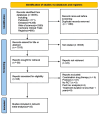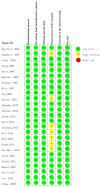Long-term effects of different hypoglycemic drugs on carotid intima-media thickness progression: a systematic review and network meta-analysis
- PMID: 38883606
- PMCID: PMC11176463
- DOI: 10.3389/fendo.2024.1403606
Long-term effects of different hypoglycemic drugs on carotid intima-media thickness progression: a systematic review and network meta-analysis
Abstract
Objective: The progression of carotid intima-media thickness (cIMT) can partially predict the occurrence of future cardiovascular events. This network meta-analysis compared the effects of 14 antidiabetic drugs (acarbose, alogliptin, exenatide, glibenclamide, glimepiride, ipragliflozin, metformin, nateglinide, pioglitazone, rosiglitazone, sitagliptin, tofoglifozin, troglitazone, voglibose) on the progression of cIMT.
Method: PubMed, EMBASE, Cochrane Library, and Web of Science were searched to screen all clinical trials of treatment of cIMT with hypoglycemic agents before March 1, 2024. The differences in the changes in cIMT between the treatment group and control group were evaluated.
Result: After screening 8395 citations, 25 studies (6675 patients) were included. The results indicated that exenatide had the best efficacy in slowing down cIMT progress, and exenatide [MD=-0.13,95%CI (-0.25, -0.01)], alogliptin [MD=-0.08,95%CI (-0.13, -0.02)] and metformin [MD=-0.05, 95%CI (-0.09, -0.02)] are more effective than placebo.
Conclusion: Long-term treatment of exenatide, alogliptin, and metformin may be more effective than other hypoglycemic drugs in slowing the progression of cIMT.
Systematic review registration: https://www.crd.york.ac.uk/PROSPERO/, identifier CRD42024519474.
Keywords: antidiabetic drug; atherosclerosis; cardiovascular; diabetes; intima-media thickness.
Copyright © 2024 Lv, Yang, Lv, Wu, Hou, Li, Ye, Yang and Wang.
Conflict of interest statement
The authors declare that the research was conducted in the absence of any commercial or financial relationships that could be construed as a potential conflict of interest.
Figures





Similar articles
-
Effects of Anti-Diabetic Drugs on Fracture Risk: A Systematic Review and Network Meta-Analysis.Front Endocrinol (Lausanne). 2021 Oct 14;12:735824. doi: 10.3389/fendo.2021.735824. eCollection 2021. Front Endocrinol (Lausanne). 2021. PMID: 34721294 Free PMC article.
-
The comparative impact among different intensive statins and combination therapies with niacin/ezetimibe on carotid intima-media thickness: a systematic review, traditional meta-analysis, and network meta-analysis of randomized controlled trials.Eur J Clin Pharmacol. 2021 Aug;77(8):1133-1145. doi: 10.1007/s00228-021-03113-0. Epub 2021 Feb 18. Eur J Clin Pharmacol. 2021. PMID: 33604752
-
Effect of the treatment of Type 2 diabetes mellitus on the development of cognitive impairment and dementia.Cochrane Database Syst Rev. 2017 Jun 15;6(6):CD003804. doi: 10.1002/14651858.CD003804.pub2. Cochrane Database Syst Rev. 2017. PMID: 28617932 Free PMC article.
-
Systemic pharmacological treatments for chronic plaque psoriasis: a network meta-analysis.Cochrane Database Syst Rev. 2021 Apr 19;4(4):CD011535. doi: 10.1002/14651858.CD011535.pub4. Cochrane Database Syst Rev. 2021. Update in: Cochrane Database Syst Rev. 2022 May 23;5:CD011535. doi: 10.1002/14651858.CD011535.pub5. PMID: 33871055 Free PMC article. Updated.
-
Comparative effectiveness of multiple different treatment regimens for nonalcoholic fatty liver disease with type 2 diabetes mellitus: a systematic review and Bayesian network meta-analysis of randomised controlled trials.BMC Med. 2023 Nov 16;21(1):447. doi: 10.1186/s12916-023-03129-6. BMC Med. 2023. PMID: 37974258 Free PMC article.
Cited by
-
The Effect of Carotid Atherosclerosis on the Risk for Open-Angle Glaucoma.Invest Ophthalmol Vis Sci. 2025 Jul 1;66(9):9. doi: 10.1167/iovs.66.9.9. Invest Ophthalmol Vis Sci. 2025. PMID: 40600760 Free PMC article.
References
-
- Lorenz MW, Polak JF, Kavousi M, Mathiesen EB, Völzke H, Tuomainen TP, et al. . Carotid intima-media thickness progression to predict cardiovascular events in the general population (the PROG-IMT collaborative project): a meta-analysis of individual participant data. Lancet. (2012) 379:2053–62. doi: 10.1016/s0140-6736(12)60441-3 - DOI - PMC - PubMed
-
- Willeit P, Tschiderer L, Allara E, Reuber K, Seekircher L, Gao L, et al. . Carotid intima-media thickness progression as surrogate marker for cardiovascular risk: meta-analysis of 119 clinical trials involving 100 667 patients. Circulation. (2020) 142:621–42. doi: 10.1161/circulationaha.120.046361 - DOI - PMC - PubMed
Publication types
MeSH terms
Substances
LinkOut - more resources
Full Text Sources
Medical

